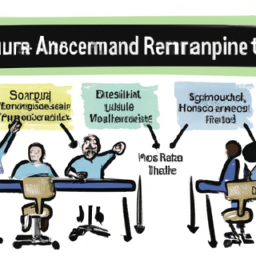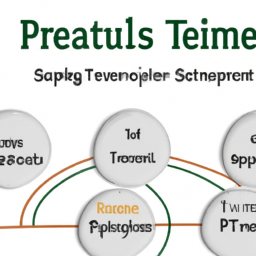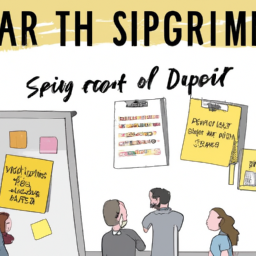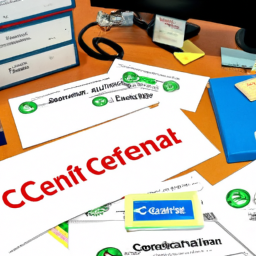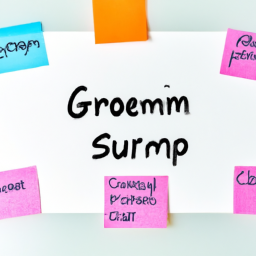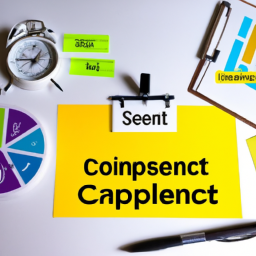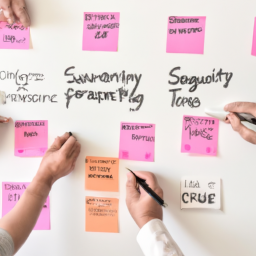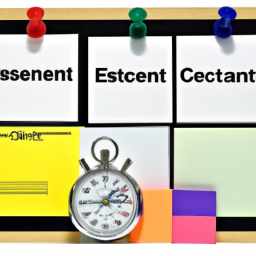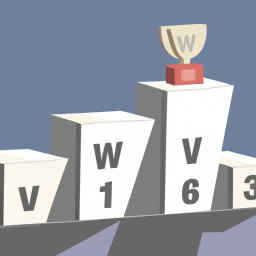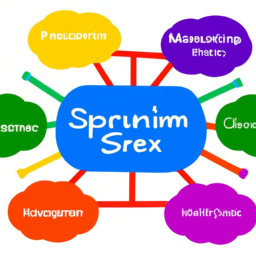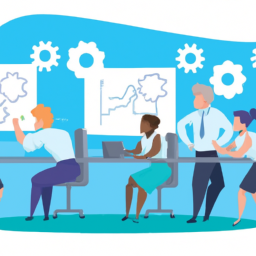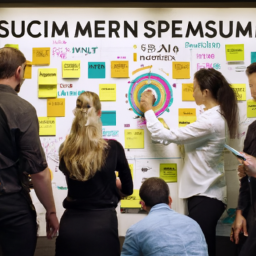Are you ready to ace the SCRUM exam?
Get ready to dive into the 11 essential topics that will push you closer to success.
From understanding Scrum principles and values to mastering Scrum roles and responsibilities, this article has got you covered.
With a concise and organized approach, we’ll guide you through Scrum events, artifacts, and the skills needed to excel as a Scrum Master.
So, buckle up and let’s get you ready for the SCRUM exam!
Key Takeaways
- Scrum is based on agile development practices and emphasizes transparency, inspection, and adaptation.
- Following Scrum principles and values can increase productivity and deliver high-quality products.
- The Scrum framework consists of roles (Product Owner, Scrum Master, and Development Team), events (Sprint Planning, Daily Scrum, Sprint Review, and Sprint Retrospective), and artifacts (Product Backlog, Sprint Backlog, Increment, and Burndown Chart).
- The Scrum Team works collaboratively to ensure effective project management and goal achievement, while the Scrum Master plays a crucial role in facilitating the Scrum process and removing obstacles.
Scrum Principles and Values
Scrum principles and values are essential for success in the exam. Understanding the principles and values of Scrum is crucial for implementing Scrum effectively in a project.
Scrum is based on agile development practices, which emphasize collaboration, adaptability, and continuous improvement. By following Scrum principles, such as transparency, inspection, and adaptation, teams can foster better communication, increase productivity, and deliver high-quality products.
Values like commitment, courage, focus, openness, and respect are the guiding principles that drive the Scrum framework. By embracing these values, teams can create a culture of trust and collaboration, enabling them to work together efficiently and overcome challenges.
Now that we have explored the importance of Scrum principles and values, let’s dive into the next section about the Scrum framework.
Scrum Framework
In this discussion, you’ll gain a clear understanding of the roles in the Scrum framework. This includes the Scrum Master, Product Owner, and Development Team.
We’ll also provide an overview of the key events in Scrum. These include the Sprint Planning, Daily Scrum, Sprint Review, and Sprint Retrospective.
Scrum Roles Explained
Are you familiar with the roles in Scrum and how they contribute to the success of a project?
In Scrum, there are three main roles: the Product Owner, the Scrum Master, and the Development Team.
The Product Owner is responsible for prioritizing the product backlog and ensuring that the team is working on the most valuable features.
The Scrum Master is the facilitator of the Scrum process and is responsible for removing any obstacles that may hinder the team’s progress.
Lastly, the Development Team is responsible for delivering the product increment at the end of each sprint.
These roles work together in a collaborative manner, forming the Scrum Team.
This team dynamic ensures that the project is managed effectively and that the goals are achieved.
Scrum Events Overview
The Scrum events provide opportunities for you and your Scrum Team to collaborate and inspect your progress, ensuring continuous improvement. There are four main types of Scrum events: Sprint Planning, Daily Scrum, Sprint Review, and Sprint Retrospective.
During Sprint Planning, you and your team determine the Sprint Goal and create a plan for how to achieve it. The Daily Scrum is a 15-minute meeting where you discuss what you did yesterday, what you plan to do today, and any obstacles you’re facing.
The Sprint Review is held at the end of the Sprint and involves showcasing the completed work to stakeholders. Finally, the Sprint Retrospective is a reflection on the Sprint, identifying what went well and areas for improvement.
Each Scrum event plays a crucial role in helping you and your team stay aligned, focused, and accountable to the Sprint goals. By actively participating and leveraging these events effectively, you can enhance collaboration, track progress, and continuously improve your work.
Scrum Roles and Responsibilities
Get ready to dive into the important topic of Scrum Roles and Responsibilities.
In the world of agile project management, understanding the different roles and responsibilities within a Scrum team is crucial for success. Here are some key points to keep in mind:
-
Scrum Master: The Scrum Master acts as a facilitator, ensuring the team adheres to Scrum principles and practices. They remove obstacles and enable the team to deliver high-quality products.
-
Product Owner: The Product Owner represents the stakeholders and is responsible for maximizing the value of the product. They prioritize the product backlog and make decisions based on customer needs.
-
Development Team: The Development Team consists of professionals who work together to deliver increments of a product. They are self-organizing and cross-functional, taking ownership of delivering value.
-
Stakeholders: The stakeholders are individuals or groups with an interest in the product. They provide feedback and contribute to the product’s success.
Understanding these roles and their dynamics is crucial for effective collaboration and successful project delivery.
Scrum Events and Timeboxes
In Scrum, it’s important to understand the purpose and time constraints of the different events and timeboxes. Scrum event planning and time management are crucial for the success of a project.
The events in Scrum include the Sprint Planning, Daily Scrum, Sprint Review, and Sprint Retrospective. Each event serves a specific purpose and has a set timebox, ensuring efficient communication and collaboration within the team.
For example, the Sprint Planning event helps the team decide what can be accomplished in the upcoming sprint and creates a plan to achieve those goals. Timeboxing these events ensures that they are focused and time-bound, allowing for better control over the project’s progress.
By understanding the purpose and time constraints of these events, you can effectively plan and manage your time in Scrum.
Transitioning into the next section about Scrum artifacts, let’s explore how these events tie in with the overall framework.
Scrum Artifacts
In this discussion, you will explore the purpose and types of artifacts in Scrum, as well as their lifecycle management. Understanding the purpose of artifacts will help you see how they contribute to the overall success of a Scrum project.
Additionally, learning about the different types of artifacts and how to effectively manage their lifecycle will ensure that you have a clear and organized approach to handling project documentation.
Artifact Purpose and Types
I’m sure you’re aware of the purpose and types of artifacts covered in the scrum exam. Scrum places great emphasis on the artifact creation process, which involves creating and maintaining various artifacts throughout the project. These artifacts serve a crucial purpose in ensuring visibility and transparency within the scrum framework.
Here are four key points to evoke emotion in you:
- The Product Backlog helps prioritize work and ensures everyone is aligned.
- The Sprint Backlog provides a clear plan for the current sprint, fostering collaboration and focus.
- The Increment showcases the tangible progress made at the end of each sprint, instilling a sense of accomplishment.
- The Burndown Chart visualizes the team’s progress, fueling motivation and accountability.
Artifact Lifecycle Management
Now that you understand the purpose and types of artifacts, let’s delve into artifact lifecycle management. This process ensures the efficient tracking and documentation of artifacts throughout their lifespan.
Artifact tracking involves keeping a record of each artifact’s status, updates, and changes. By implementing a tracking system, you can easily monitor the progress of artifacts and identify any potential issues or delays. This helps to ensure that the project stays on track and that all artifacts are accounted for.
Artifact documentation is an essential part of the lifecycle management process. It involves creating and maintaining detailed records of each artifact, including its purpose, requirements, design, and any associated documentation. This documentation serves as a reference for team members and stakeholders, facilitating collaboration and providing a historical record of the project.
Product Backlog Management
Take a moment to review your techniques for effective product backlog management. Here are some key aspects to consider:
-
Product Backlog Prioritization: Prioritizing items in the product backlog helps you focus on delivering the most valuable features first, ensuring customer satisfaction and maximizing the return on investment.
-
User Story Refinement: Refining user stories involves breaking them down into smaller, more manageable tasks and adding more details to ensure clarity and understanding among the team members.
-
Continuous Improvement: Regularly reviewing and refining the product backlog is crucial to adapt to changing priorities and customer needs, improving the overall efficiency and effectiveness of the development process.
-
Collaboration and Communication: Maintaining open lines of communication and collaborating with stakeholders, product owners, and the development team is essential to ensure a shared understanding of the product backlog and its priorities.
Sprint Planning
To effectively plan your sprint, start by reviewing your prioritized product backlog and selecting the most valuable items to work on.
The sprint backlog is created by taking a subset of the product backlog items and breaking them down into user stories, which are smaller, manageable units of work. These user stories serve as the building blocks for the sprint, outlining the specific features or functionality that will be developed.
During sprint planning, the team collaborates to estimate the effort required for each user story and determines how many can be completed within the sprint timeframe. By prioritizing and selecting the most valuable items from the product backlog, you ensure that the team is working on the highest-priority tasks and delivering value to the customer. This sets the stage for a successful sprint.
Now, let’s move on to the next step in the scrum process: the daily scrum.
Daily Scrum
During the daily scrum, you’ll have the opportunity to provide a brief update on your progress and discuss any potential roadblocks with the rest of the team. This meeting is a key component of agile development, allowing for transparency, collaboration, and adaptability.
Here are some aspects of the daily scrum that you should keep in mind:
-
Timeboxed: The daily scrum is a short, timeboxed meeting usually lasting no more than 15 minutes.
-
Stand-up: It is typically conducted in a standing position to promote a sense of urgency and focus.
-
Three Questions: Each team member answers three questions: What did you do yesterday? What will you do today? Are there any impediments in your way?
-
Problem-solving: If any roadblocks are raised, the team can collaborate to find solutions and ensure progress continues.
By participating actively in the daily scrum, you contribute to the team’s success and enable a smoother workflow.
Now, let’s move on to the next important aspect of the scrum framework: the sprint review.
Sprint Review
The sprint review is an opportunity for you to showcase the completed work and gather feedback from stakeholders. It is a crucial part of the Scrum framework and plays a significant role in ensuring the success of your project.
During the sprint review, you will present a demo of the work that was completed during the sprint. This demo allows stakeholders to see the progress made and provides them with a chance to provide feedback. This feedback is essential as it helps the team identify any areas for improvement and make necessary adjustments for future sprints.
Sprint Retrospective
The sprint retrospective is an important meeting where the team reflects on the past sprint and identifies areas for improvement. It is a crucial part of the Scrum framework, as it promotes continuous improvement and team reflection.
During this meeting, the team discusses what went well, what didn’t go so well, and what can be done differently in the future. By actively engaging in this process of self-reflection, the team can identify patterns, address any issues, and make necessary adjustments to enhance their performance.
The sprint retrospective is an opportunity for the team to learn and grow together, fostering a culture of collaboration and innovation. It sets the stage for the next sprint, as the team applies their insights and lessons learned to achieve even greater success.
Transitioning into the subsequent section about ‘scrum master skills and techniques’, the sprint retrospective provides valuable insights for the Scrum Master to facilitate the team’s growth and development.
Scrum Master Skills and Techniques
In this discussion, you will explore three key points related to Scrum Master Skills and Techniques:
-
Effective Team Collaboration: You will learn how to foster a collaborative environment where team members can work together efficiently and effectively.
-
Agile Project Management: You will gain insight into the principles of agile project management and how to apply them in your role as a Scrum Master.
-
Facilitating Stakeholder Communication: Finally, you will discover strategies for effectively communicating with stakeholders to ensure their needs and expectations are met throughout the project.
Effective Team Collaboration
Are you ready to see how effective team collaboration can greatly enhance your project’s success?
When it comes to team building, establishing a strong foundation is essential. Encouraging open communication and fostering a positive work environment can lead to better collaboration.
Conflict resolution is another crucial aspect of team collaboration. By addressing conflicts in a timely and constructive manner, you can prevent them from escalating and negatively impacting the project.
Effective team collaboration can result in increased productivity, improved decision-making, and enhanced creativity. It also promotes a sense of unity and mutual support among team members, which can lead to greater job satisfaction and motivation.
With these skills in place, you’ll be well-equipped to tackle the upcoming section on agile project management.
Unordered Bullet List:
- Establishing open communication
- Fostering a positive work environment
- Addressing conflicts constructively
- Promoting unity and mutual support
With these skills in place, you’ll be well-equipped to tackle the upcoming section on agile project management.
Agile Project Management
Let’s dive into how agile project management can streamline processes and increase efficiency within your team.
Agile project management is a flexible and iterative approach to managing projects. It focuses on collaboration, adaptability, and continuous improvement.
By breaking down projects into small, manageable tasks, agile project management allows for better visibility and control over the project’s progress. It encourages frequent communication and feedback loops, ensuring that the team stays aligned and can quickly adapt to changes.
The scrum exam covers various aspects of agile project management, including the roles and responsibilities of the scrum team, the scrum framework, and key agile practices.
By understanding and implementing agile project management principles, you can enhance your team’s productivity and deliver high-quality results.
Facilitating Stakeholder Communication
Now that you have a solid understanding of Agile Project Management, let’s dive into the next important topic: Facilitating Stakeholder Communication. Effective stakeholder engagement is crucial for the success of any project.
To ensure smooth communication, you need to employ the right strategies. Here are some key communication strategies to consider:
-
Active Listening: Show genuine interest and attentiveness when stakeholders express their concerns or ideas.
-
Clear and Concise Communication: Use simple language to convey information and avoid jargon or technical terms that may confuse stakeholders.
-
Regular Updates: Keep stakeholders informed about project progress, milestones, and any changes in a timely manner.
-
Two-Way Communication: Encourage stakeholders to provide feedback and actively seek their input to ensure their needs and expectations are met.
Frequently Asked Questions
How Often Should a Scrum Master Conduct the Daily Scrum Meeting?
As a scrum master, you play a pivotal role in conducting the daily scrum meeting. This meeting, held every day, allows the team to synchronize and plan their work.
It is crucial for you to ensure that the meeting is conducted efficiently, keeping it time-bound and focused. By facilitating open communication, addressing any roadblocks, and fostering collaboration, you can maximize the benefits of this daily ritual.
What Are Some Common Challenges Faced by Scrum Teams During the Sprint Review?
During the sprint review, scrum teams often face common challenges. These challenges can include ineffective communication, lack of stakeholder engagement, and difficulty in prioritizing feedback.
It is important for you, as a scrum team member, to address these challenges proactively. Ensure that communication channels are open and effective, involve stakeholders throughout the review process, and prioritize feedback based on its impact on the product.
How Can the Product Owner Ensure That the Product Backlog Is Properly Prioritized?
So, you want to know how the product owner can ensure that the product backlog is properly prioritized? Well, let me tell you, it’s all about product backlog refinement and sprint planning.
The product owner needs to actively work with the team to regularly review and prioritize the items in the backlog. This ensures that the most valuable and important items are at the top, ready to be tackled in the next sprint.
It’s a crucial step in keeping the team focused and productive.
What Are Some Recommended Techniques for Facilitating Effective Communication Within a Scrum Team?
To facilitate effective communication within a Scrum team, there are recommended techniques you should know.
First, encourage open and transparent communication by promoting a safe and non-judgmental environment.
Utilize daily stand-up meetings to provide updates and identify any obstacles.
Use visual aids like task boards and burndown charts to enhance clarity and understanding.
Foster collaboration through regular team retrospectives and encourage feedback from all team members.
How Can a Scrum Master Support the Development Team When They Encounter Obstacles or Roadblocks During a Sprint?
When the development team faces obstacles or roadblocks during a sprint, the Scrum Master plays a crucial role in providing support. They are there to help the team overcome challenges and keep the sprint on track.
Conclusion
Congratulations, you’ve reached the end of the article!
Now that you’re familiar with the 11 essential topics covered in the Scrum exam, you’re well-equipped to tackle any challenge that comes your way.
Just like a skilled orchestra conductor brings harmony to a performance, mastering these Scrum principles and techniques will enable you to guide your team towards success.
So, go ahead and apply your newfound knowledge, and watch your projects soar to new heights.
Good luck on your Scrum journey!


